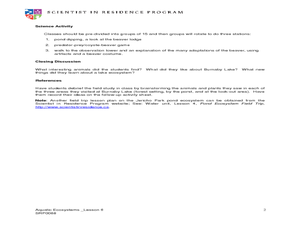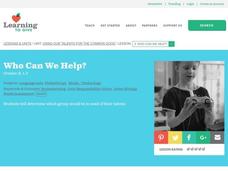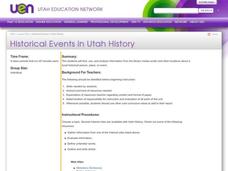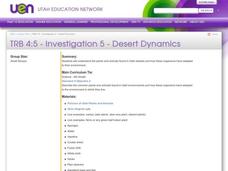Curated OER
TEXTURE DRAWING
Third graders create a drawing based upon objects found outdoors through rubbing the side of a crayon onto a piece of paper covering the objects, to demonstrate different textures. They share their different drawings and verbally compare...
Curated OER
Tune Up Your Ears!
Students discuss meaning of pitch, listen for different sounds in classroom, hallway, and outdoors, and listen to sounds played on piano and on computer to determine high or low pitch.
Curated OER
Nature Notes
Learners spend some time outdoors and record their observations of abiotic conditions, geologic surroundings and living organisms. They reflect and write about the experience of being observant in nature.
Curated OER
The Science of Weather: Humidity makes air feel even hotter.
Students examine the effects of heat and humidity. In this weather lesson, students read a chart to determine the effects heat and humidity can have on the human body. This lesson includes an optional extension activity using a newspaper.
Curated OER
Houses in Japan
First graders compare the everday lives of school-aged children in the United States and Japan by comparing the houses they live in. They discuss how traditional Japanese houses are designed with a feeling of opennes to the outdoors and...
Curated OER
What's Down There
Third graders gather and examine samples from the school outdoor environment. They compare/contrast their samples with those of other students. Students record the results of their observations.
Curated OER
Mini-Squares of Life
Students brainstorm to decide the best way to mark off square areas (that they will later study) that are smaller than one meter. They compare the suitability of different designs and create "mini-square markers." Finally, they test...
Curated OER
Pulling Together With Natives -- The Bradley Sisters' Story
Students identify the four ways to stop the spread of weeds in California. In groups, they practice the five methods of removing and controling the spread of the weeds. To end the lesson, they summarize the Bradley sisters way of...
Curated OER
Learning By Bees
High schoolers investigate learning by bees as related to vision and foraging behavior. The experiment is done outdoors where bees are foraging for food. They make their observations and record their data which is shared with the class.
Curated OER
The Quest for Independence
Students explore how settlers created and cooked over open fires. In this home economics lesson, students will learn how to make a safe, open fire and will cook a meal over it.
Curated OER
The Voice of the Individual
Students examine the role of the individual in society as a whole. Individually, they design and create their own calling card as used in the past. They put together an art kit in which they are able to use outdoors. To end the...
Curated OER
Colors, Colors What Do You See?
Learners study their colors by reading a book Brown, Bear, Brown Bear and take pictures of colors. In this color recognition lesson, students read the book and sing a song about colors. Learners then take pictures of various colors using...
Curated OER
Peekikng At Public Sculpture
Students use the internet to investigate public examples of sculpture. They reflect upon the possibility of being a reference of lifestyles that can exist in a society. A variety of media sources serve as inspiration for the lesson.
Curated OER
Children's Health: Children Aren't Little Adults
This lesson is a compilation of interdisciplinary, technology-infused activities that focus on the often complicated and sometimes controversial issues related to toxic chemicals in children's environment. Special emphasis is placed on...
Curated OER
Little Me in a Big World: Ants
Students use the life cycle of an ant to learn about their own self-esteem. In this self-esteem lesson, students read books about ants and discuss obstacles from the stories as well as the ant behavior.
Curated OER
Funky Food Farm
Students research about ways to keep food from spoiling. In this health science lesson, students design an experiment to keep the ice cubes from melting. They present their designs and results in class.
Curated OER
Burnaby Lake Field Trip
Students identify different organisms found in the lake ecosystem. In this life science lesson, students discover the predator-prey relationship through a game. They explain how beavers adapt to the environment over time.
Curated OER
Introduction to Macroinvertebrates
Third graders investigate the world of macroinvertebrates and identify the environmental stressors that threaten their existence. Outdoors, they role-play as stressors and invertebrates, with the intolerant species doing pushups, spins,...
Curated OER
Weedy Socks & Wheels
Students engage in a lesson that is concerned with the concept of using socks in order to collect weed seeds. They conduct research in order to illustrate the ease of how weeds are spread from one area to another. Students conduct the...
Curated OER
Who Can We Help?
Young scholars define philanthropy. In this community service lesson, students assess as a group who at school needs help. Young scholars write letters to offer their assistance where they've found areas of need.
Curated OER
Why Do We Need Clean Air?
Students recognize that tobacco smoke is bad for the heart. In this healthy choices lesson plan, students understand the relationship between tobacco smoke and damage to the body.
Curated OER
Science: The Shape of Clouds
Pupils observe cloud formations during a trip outdoors prior to reading Tomie dePaola's , "The Cloud Book." Using cotton, they make models of the four main cloud shapes and mount them on blue construction paper. As an ongoing project,...
Curated OER
Historical Events in Utah History
Fifth graders choose a topic they are interested in related to the history of Utah. Using the internet, they research the topic making sure to cite where they gathered the information and take notes. To end the lesson, they write their...
Curated OER
Desert Dynamics
Fourth graders examine the various types of plants and animals found in the deserts of Utah. In groups, they discover how the plants and animals have adapted to the harsh environment. To end the instructional activity, they compare and...























